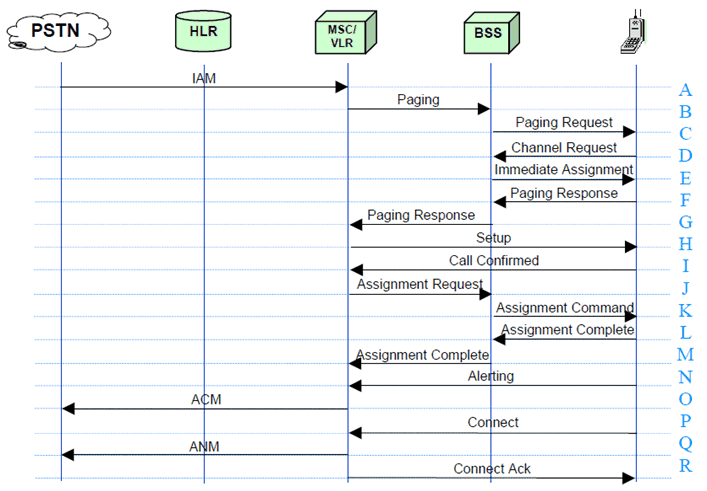Content for TR 22.952 Word version: 18.0.1
0…
4…
4.8…
5
5.1
5.2
5.3
5.4
5.5
5.6
5.7
5.8
5.9
5.10
5.11
5.12
5.13
6…
A…
B
B.1
B.2
B.3
B.4
B.5
B.6
B.7
B.8
B.9
C
D…
5.2 Priority service call termination - radio resources available, call not queued p. 19
This clause illustrates a Mobile Terminated (MT) Priority Service call establishment with early assignment when the incoming Priority Service call to a wireless called party is received at a terminating MSC. In this scenario, radio traffic channels are available when the incoming call is received. With the early assignment option, the PLMN initiates the assignment of a traffic channel upon receiving the Call Confirmed message from the MS.

Step 1.
Immediate Assignment Procedure (Establish a Radio Resource (RR) connection between the MS and the BSS)
A.
Step 2.
The MSC/VLR receives an ISUP IAM message from the PSTN which includes the Calling Party's Category parameter set to the IEPS call marking for preferential call set up and may include the Precedence parameter.
B.
On receipt of the ISUP IAM message, the MSC/VLR sends a Paging message to the BSS.
C.
The BSS initiates the paging procedure to trigger RR connection establishment by broadcasting a Paging Request message on the appropriate paging subchannel on CCCH. The BSS starts RR timer T3113.
D.
On receipt of the Paging Request message from the BSS, the MS sends a Channel Request message, which includes the establishment cause "answer to paging", to the BSS on the RACH channel. Having sent M + 1 Channel Request messages, the MS starts RR timer T3126. M is the value of the parameter "max retrans" broadcast on the BCCH.
E.
The BSS allocates a dedicated channel to the MS by sending an Immediate Assignment message on the same CCCH timeslot on which it has received the Channel Request message. The BSS starts RR timer T3101.
Service Request and Contention Resolution Procedure (Establish the main signalling link between the MS and the BSS)
F.
Step 3.
The MS stops RR timer T3126 on receipt of an Immediate Assignment message corresponding to one of its three last Channel Request messages. The MS stops sending Channel Request messages, sets the channel mode to signalling only, and activates the assigned channels.
G.
- The Paging Response message is sent by the MS to the BSS piggybacked in a L2 SABM frame to establish the main signalling link. The BSS stops RR timer T3101 when the main signalling link is established. The BSS stops RR timer T3113 on receipt of the Paging Response message. Contention resolution is achieved by the BSS by including the same Paging Response message, received in the L2 SABM frame, in a L2 UA frame and sending it to the MS.
On receipt of the Paging Response message, the BSS passes the L3 Paging Response message to the MSC/VLR using a Complete Layer 3 Information message.
Mobile Terminating Call Establishment Procedure
H.
Step 4.
The MSC/VLR sends a Setup message to the MS after receiving the Paging Response message from the MS. The MSC/VLR starts CC timer T303.
I.
The MS acknowledges the receipt of the Setup message by returning a Call Confirmed message to the MSC/VLR. On receipt of the Call Confirmed message, the MSC/VLR stops CC timer T303 and starts CC timer T310.
Traffic Channel Assignment (Early Assignment)
J.
Step 5.
The MSC/VLR sends an Assignment Request message to the BSS, which includes the call priority level and the queuing allowed indicator.
K.
- When the Calling Party's Category parameter set to the IEPS call marking for preferential call set up and the Precedence parameter are received in the ISUP IAM message, the call priority level is based on the value received in the Precedence parameter.
- When the Calling Party's Category parameter set to the IEPS call marking for preferential call set up is received in the ISUP IAM message and the Precedence parameter is not received in the ISUP IAM message, the call priority level is based on a default value in the MSC/VLR.
As an idle radio traffic channel is available, the BSS initiates the channel assignment procedure by sending an Assignment Command message to the MS on the main signalling link and starts BSS Management Application Part (BSSMAP) timer T10 and RR timer T3107.
L.
On receipt of the Assignment Command message, the MS initiates the activation of the channels, their connection, and the establishment of the main signalling links. After the main signalling link is successfully established, the MS returns an Assignment Complete message, specifying cause "normal event", to the network on the main DCCH.
M.
On receipt of the Assignment Complete message, the BSS releases the previously allocated resources, stops RR timer T3107, and stops BSSMAP timer T10. On successful assignment of the required channels, the BSS returns an Assignment Complete message to the MSC/VLR.
Alerting Procedure
N.
Step 6.
The MS initiates user alerting by generating an appropriate tone or indication at the MS and by sending an Alerting message to the MSC/VLR.
O.
On receipt of the Alerting message, the MSC/VLR stops CC timer T310, starts CC timer T301, and sends an ISUP ACM message to the calling party.
Call Connect Procedures
P.
The MS indicates acceptance of a mobile terminating call by sending a Connect message to the MSC/VLR. The MS starts CC timer T313.
Q.
On receipt of the Connect message, the MSC/VLR sends an ISUP ANM message to the calling party.
R.
On receipt of a Connect message, the MSC/VLR connects the traffic channel, stops CC timers T310, T303 or T301 (if running), and returns a Connect Acknowledge message to the MS. Upon receipt of a Connect Acknowledge message, the MS stops CC timer T313